#Fixes nitrogen in the soil
Text

Still playing around with the camera settings on my phone when I go for walks (this was #64). Took a surprisingly nice photo of a sign and some tufted vetch (with bonus bumblebee) at the top of the many flights of stairs down to the old high school (now grade school) in the bottom of what was once a gravel pit. I like the depth of field the portrait mode gives, it's much more attractive than the trying-to-be-sharp-everywhere of the regular photo mode.
Still failing to get the hang of the macro setting, even when I'm the right distance I get poor results. This was the best I managed out of multiple attempts along my route:

#MsB goes for a walk#Bumblebee#Tufted Vetch#I once won a scrabble game by spelling vetch iirc#My BIL didn't believe it was a real word and challenged#Which surprised me because he was a life-long gardener#And you see (introduced) vetch growing wild all over the place#It's a good weed#Fixes nitrogen in the soil#Native bees like it#Not toxic to animals#Cows love it#It's in the pea family#I called it 'cannonball plant' growing up because of the round black seeds
4 notes
·
View notes
Text
i will kill all idiots who think wildflower patches are like. Every Wild Beast Who I Hate Habitat. there are fleas and ticks in your lawn too. there are MORE TICKS in places with less mammals coming through (deer, squirrels, etc that the ticks can feed on instead of u) and insecticides/herbicides kill off beneficial insects so there’s more habitat for ticks to hang around. and if you aren’t attracting birds with seed or WILDFLOWERS THAT NATURALLY MAKE SEED FOR BIRDS then you will have MORE pests.
people are just so stupid instead of planting things to attract bugs and birds they WANT that will do bad insect management they just keep going down the line of killing everything and making uninhabitable space. but ig its “safer for kids” (your kids will just get sick from playing in roundup!!!) or you wont have to see a fucking garter snake. oh the horror. kids should be exposed to plants and animals and clearly ppl who think that a wilder lawn will just be fucking pest central didn’t play enough outside. and tbh im blaming YOU for my neighbor who removed the blackberry bush as soon as he moved in that neighborhood kids had been eating for years…
#also lawns ARE ugly. they are#nothing is more hideous to me than a lawn that has been so chemically enhanced that it has NO other plants among it#our front lawn has three grasses and many clover and some sainfoin and chickweed and dandelion#we let it bloom before each time we cht it back to keep it from becoming 2 fr tall#dandelion loosens and aerates soil so you dont have to have those lawn dudes poke at it#clover fixes nitrogen into the soil for healthier plant growth all around!#and letting them flower so bees and butterflies can feed is beneficial in that we need them for the majority of plants#people really dont realize how MUCH nectar and pollen bees need!!!!#where i work they have 2 honeybee hives that are struggling#even though every house has gardens! and they have a butterfly garden! and many flowering plants near!#the lawns are absolutely destroyed and lifeless#so these bees are traveling so far to meet their needs
4 notes
·
View notes
Video
youtube
#permaculture#save soil#soil#save our soil#food security#the nitrogen cycle#nitrogen fixing#how to fertile soil#how to restore soil#regenerative agriculture#how to build soil
5 notes
·
View notes
Text
Growing Sweet Peas in Phoenix, Arizona: A Blooming Success in the Desert
When you think of Phoenix, Arizona, a lush garden filled with delicate sweet pea flowers might not be the first thing that comes to mind. However, with a little know-how and some careful planning, growing sweet peas in the desert climate of Phoenix can be a blooming success. In this blog post, we’ll explore some valuable tips and tricks to help you cultivate these fragrant and vibrant flowers…
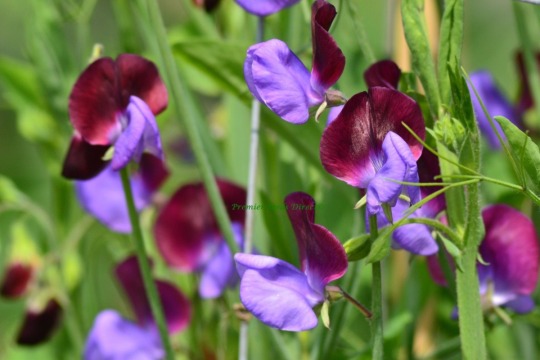
View On WordPress
#backyard blooms#Container Gardening#cool season plants#desert gardening#flower gardening#Fragrant Flowers#garden soil preparation#Garden Tips#gardening in Phoenix#Heat-Tolerant Plants#legume care#nitrogen-fixing bacteria#organic gardening#ornamental plants#planting guide#spring flowers#Sustainable Gardening#sweet peas#Urban Gardening
1 note
·
View note
Text
Worms helping to feed the world - YouTube
Worms helping to feed the world – YouTube
youtube
View On WordPress
1 note
·
View note
Text
The knowledge of some common plants
Since many people don't know most of the plants around them, this is information on some plants that are commonly seen in many places throughout the world

This is Lamium purpureum, also called Purple Deadnettle.
It's called deadnettle because it looks like a nettle but it doesn't sting you
This plant is a winter annual—it grows its leaves in the fall, lasts through the winter, and blooms and dies in the spring
Its pollen is reddish orange. If you see bees with their heads stained reddish orange, it is likely because they have visited Purple Deadnettle
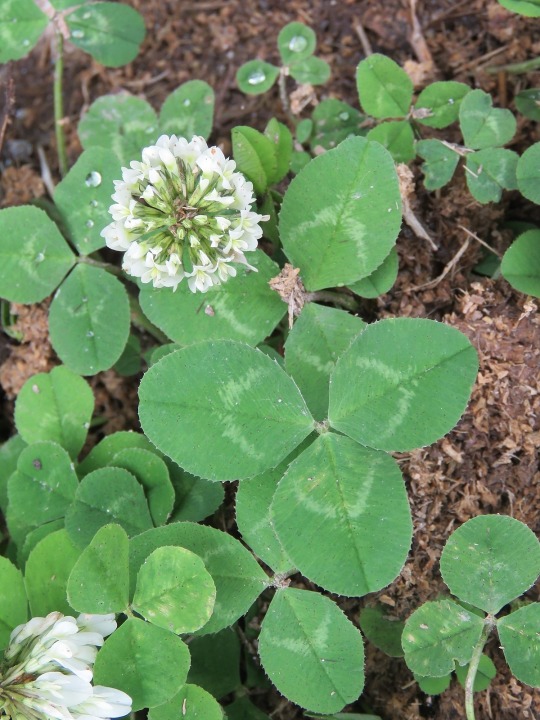
This is Trifolium repens, white clover
It is a legume (belongs to the bean family) and fixes nitrogen using symbiosis with bacteria that live in little nodules on its roots, fertilizing the soil
It is a good companion plant for the other members of a lawn or garden since it is tough, adaptable, and improves soil quality. According to my professor it used to be in lawn mixes, until chemical companies wanted to sell a new herbicide that would kill broadleaved plants and spare grass, and it was slandered as a weed :(
It is native only to Europe and Central Asia, but in the lawns they are doing more good than harm most places
Honeybees love to visit clover
Four-leaf clovers are said to be lucky
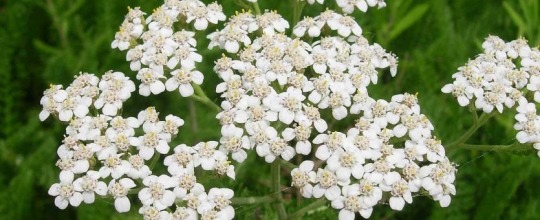
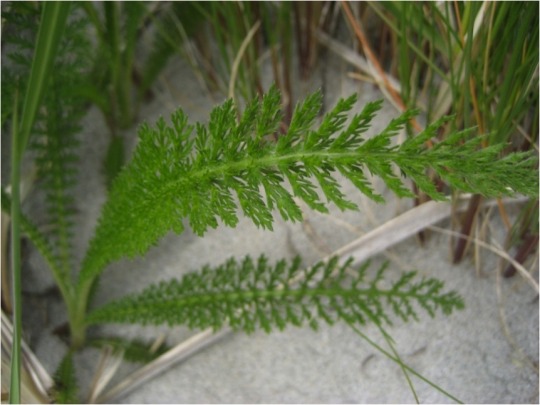
This is Achillea millefolium, Common Yarrow
It has had a relationship with humans since Neanderthals were around, at least 60,000 years, since Neanderthals have been found buried with Yarrow
Its leaves have been used to stop bleeding throughout history, and its scientific name comes from how Achilles was said to have used Yarrow to stop the blood from the wounds of his soldiers. A leaf rolled into a ball has been used to stop nosebleeds
It is a native species all throughout Eurasia and North America

This is Cichorium intybus, known as Chicory
The leaves look a lot like dandelion leaves, until in mid-spring when it begins growing a woody green stem straight up into the air
Like many other weeds, it has a symbiotic relationship with humans, existing in a mix of domesticated or partially domesticated and wild populations
It is native to Eurasia, but widespread in North America on roadsides and disturbed places, where it descended from cultivated plants
Its root contains large amounts of inulin, which is used as a sweetener and fiber supplement (if you look at the ingredients on the granola bars that have extra fiber, they usually are partly made of chicory root) and has also been used as a coffee substitute
A large variety of bees like to feed upon it

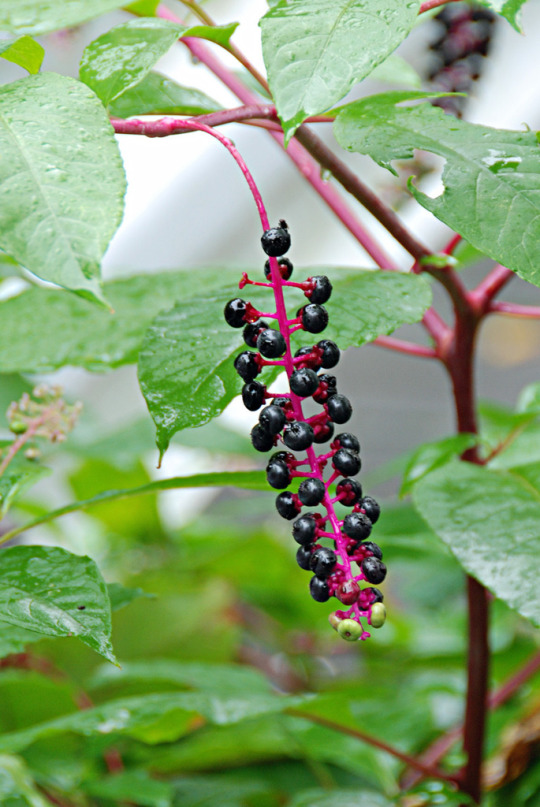
This is Phytolacca americana, known as Pokeweed
It is easily identified by its huge leaves and its waxy, bright magenta stem
It can grow more than nine feet tall from a sprout in a single summer!
If you squish the berries, the juice inside is a shocking magenta that is so bright it almost burns your eyes. For this reason many Native American people used it for pink and purple dye.
It is a heavy metal hyperaccumulator, particularly good for removing cadmium from the soil
All parts of the plant are poisonous and will make you very sick if you eat them, however if the leaves are picked when very young and boiled 3 times, changing out the water each time, they can be eaten, and this is a traditional food in the rural American Southeast, but I don't want to chance it
British people have introduced it as a pretty, exotic ornamental plant. I think that is very funny considering that here it is a weed associated with places where poor people live, but maybe they're right and I need to look closer to see the beauty.
If you see magenta stains in bird poop it is because they ate pokeweed berries- birds can safely eat the berries whereas humans cannot

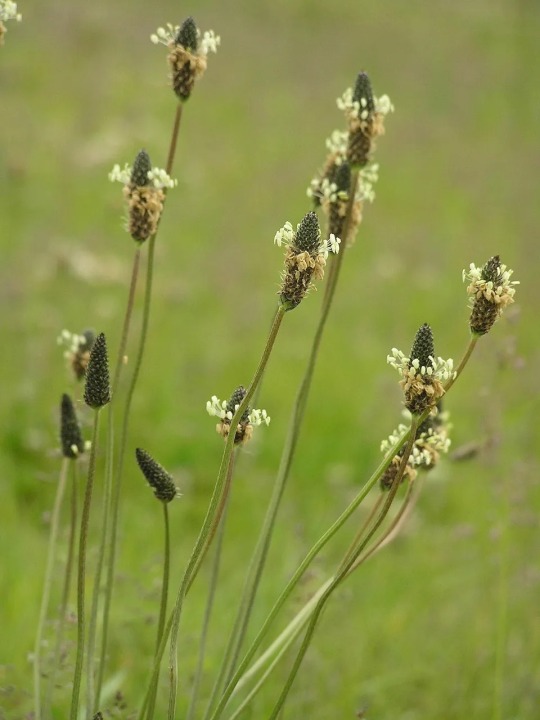
This is Plantago lanceolata, Ribwort Plantain
It grows in heavily disturbed soils, in fact it is considered an indicator of agricultural activity. It is successful in the poorest, heaviest and most compacted soil.
The leaves, seeds, and flower heads are said to be edible but the leaves are really stringy unless they are very young. Of course, it is important to be careful when eating wild plants, and make sure you have identified the plant correctly and the soil is not contaminated
I have also heard the strings in the leaves can be extracted and used for textile purposes
and that's some common plants you might often see throughout the world
#just remembered i had this in my drafts#i forget why i didn't post it immediately#anyway#plants#the ways of the plants
5K notes
·
View notes
Note
I thought green onions/Alliums were nitrogen fixers, but google is telling me no, is this true?
Unfortunately, Google is right in this case - onions/Alliums aren’t nitrogen fixers. In fact, planting them near nitrogen fixers can actually keep the nitrogen fixers from putting nitrogen back into the soil. That’s because the nitrogen-fixing process relies on a bacteria that can pull nitrogen out of a plant’s roots and into the soil, and Alliums’ mild antibacterial/antimicrobial properties kill off those bacteria. They also require a lot of nutrients in general to grow (although the root/bulb-based Alliums more so than green onions), so they’re actually likely to deplete nitrogen in the soil.
If you’re interested in learning more about nitrogen fixers, this article has a big list of nitrogen-fixing plants, and this article talks more about the science behind nitrogen fixing in general. I hope this helps!
- Mod J
197 notes
·
View notes
Text
Today is George Washington Carver Day!
He was an agronomist, an innovator & an educator whose work with peanuts, soybeans & potatoes revolutionized organic agriculture in the US.
Before sustainability in farming was a trend, Carver popularized crop rotation & used peanuts as a nitrogen-fixing plant to improve soil health. While many farmers at the time sacrificed the soil for larger yields, Carver prioritized soil health while also increasing yields.

In 1914 Carver and Booker T. Washington started an outreach agricultural school on wheels for Black farmers who didn’t have access to animal vaccinations, new farming techniques, demonstrations and garden tools due to racism and discrimination.

767 notes
·
View notes
Text
I will NOT sit here doing internet research to figure out what farmers in different regions of Tamriel do to fix nitrogen in their soil if they ain't growing beans. I won't make up an entire ecology based on the absence of legumes. I will not be thinking through the economic nor infrastructural implications of any of this. There is no earthly reason for me to do this and I have other shit to do today (the search engine tab is already open)
246 notes
·
View notes
Text
One of the things I think about a lot is productivity comparisons between conventional and unconventional agriculture. Mostly because that's the first question you get asked when you talk about anything that's outside the norm*, but, on what metric are we measuring? Per acre? Per hour worked? Per cost of input? Are we measuring yields of product or dollars earned?
This question also, to me, rings of fear. Fear of food shortages, which are really a problem of greed & distribution, not the world's capacity to grow food. If we were really worried about calories though, I think we'd at least switch to pastured animals instead of sending so much corn and soy to livestock (for any non-farmers out there, you do not get nearly the calories out of a chicken or pig that you put in- you get much less**). Or we would put more effort into making cities great places to live so we stopped turning farmland into suburbia. Or we would be much more concerned with how to prevent erosion & loss of arable land. But we don't, and we're not.
I also think of the complexity of non- conventional farming, and how instead of it being a return to the past, it actually relies on new information and methods***.
Take the plot of land that I'm working to make into a market garden. It's soil is, from a farmer's perspective, crap. It's gravely, sandy, very little organic matter. If I were to farm it conventionally, I'd basically have till to open the soil and kill weeds, and then provide all of the plant nutrients through fertilizers, which would cause the plants to kick out their symbiotic fungi, leaving them vulnerable to pathogenic fungi, and more dependant on me for water. There would also be bare soil everywhere, increasing evaporation & providing plenty of opportunities for new weeds. My costs would be very high, paying for fertilizers, pesticides, & herbicides, and I would have to water, a lot. It probably wouldn't be at all economically feasible to grow food on this plot using conventional methods.
Now, I look at it and say, I'm going to do no-till. I look at the hard, weedy, depleted soil and there's no way a seed is going to be able to come up through that. But, I'm not just doing no-till, because I'm not looking at it from a conventional mindset and just trading out one practice. I'm doing basically everything different from above.
Instead of tilling, I'm laying down a thick layer of mulch, to shade out the weeds, increase soil organic matter (increasing the amount of water and nutrients the soil can absorb & good on to), and feed the soil ecosystem. By the time spring rolls around, the soil underneath will be much better, but I'll still add more compost in most cases.
Instead of fertilizers I've had to pay for, I'm using mulches that I got for free from my gardening work & composts made for free from restaurant kitchen wastes****. I'm going to use over crops, plants that fix nitrogen and also serve as perennial hosts to beneficial soil fungi, which will also form symbiosis with most of my crops, increasing their resistance to pathogenic fungi while also providing them with increased access to water and soil minerals.
Instead of bare soil, there will be mulches and cover crops every where. Instead of monocrops & pesticides, I'll be intercropping which will help by hosting beneficial native insects that will chow down on aphids and other crop pests.
From this framework, there's an upfront investment of effort and planning, but farming this land now seems feasible.
And the thing is, each of those choices is backed up by research. We know so much more now about soil and nutrient cycling and how it actually works than when conventional ag really got started. We know so much more, and so many practices are new, so growing non-conventionally isn't a step back into the past of how things were grown.
But at the same time, it's not exactly completely information either- other cultures have different ways of growing food crops, and if you broaden your concept of what cultivating plants looks like, there's examples everywhere. We're just studying it now and providing it scientifically.
*and I honestly think that it's a result of the extractive mindframe that comes from being the decendants of colonizers. Just look at the different perspectives between many western foragers ideas and Indigenous peoples' relationship with the land.
** chickens are one of the most efficient, with a feed conversion ratio of 1.6, which means for every 1.6 pounds of food you give them, you can expect the chicken to gain 1 pound (cows are over 4 pounds of feed to pound of live weight, and pigs are 3 to 4ish). That's the whole bird though, counting all the parts we don't eat- guts, feathers, bones, etc. Even so, a pound of chicken food has over 1300 calories, and is about 20% protein for starter/grower, where as a pound of chicken has about 500 calories and about 30% protein (for dark meat, you get fewer calories from white meat). I'm not saying everyone should give up meat, but I am saying that the amount of meat in mainstream diets has increased dramatically, much of it comes from cafos where animals are fed on grains & legumes, and if we're measuring productivity and yield per acre because we're worried about feeding the world, this is a huge factor. Look up how much of the corn & soy crop goes to actually directly feeding people.
*** from a western, colonizing prospective
**** is this a particular boon from my particular circumstances? Yes. But everyone has their own challenges and resources, there is no cookie-cutter solution to all agriculture, everywhere. You have to find the solutions that work for you.
782 notes
·
View notes
Text
OBSESSED with the fact that the infamous “gross American food” poll is fully just poor people food that people still make/buy either because it was passed through their family or because they’re still poor. Allow me to elaborate. Here’s the poll if you’ve managed to avoid the discourse:
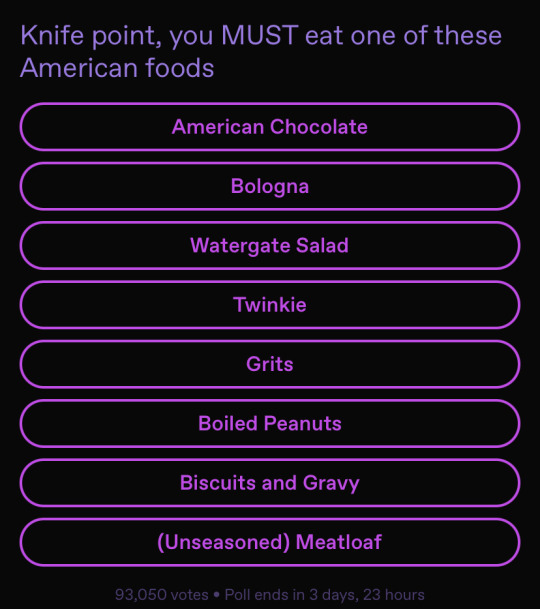
American Chocolate tastes different because of two factors: the majority of our cacao comes from South America unlike Europe which generally imports from Africa (moving product farther costs more money). Also, American chocolate is only required to have 10% cacao as opposed to Europe’s 20% (using less cacao and supplementing with readily available sweeteners like corn syrup costs less money). In fact, the very first American Chocolate company (Baker Chocolate Company) was so aware of how much less wealthy the early US was than Europe’s established market for chocolate, that their bars came with a money back guarantee for anyone who was disappointed with the sweets. The current financial situation in the US is well known to the rest of the world- of course we still make and eat cheap chocolate, the bones of our country are exploitation. Also, the dairy content is lower in American chocolates which makes them more shelf stable. Shelf stable foods are important for communities living paycheck to paycheck who have money for a chocolate bar right now but won’t for their kid’s birthday in a week.
Bologna feels self explanatory to me. It’s made of literal scraps from the meat production industry that are then turned into a “sausage” and cured to give the product more longevity. I like fried bologna because it was cheaper for my dad’s parents when he was a kid. My dad likes bologna for the same reason.
Watergate Salad is made of shelf stable ingredients. Many desserts require eggs or dairy that can be expensive and expire quickly. Those desserts then get stale if they aren’t eaten immediately. Canned fruits, pistachio pudding mix, and cool whip (which is hydrogenated oil and very little dairy) will all keep for a while. You can buy them in bulk and put them in your cabinets or freezer until you want to use them and then the salad itself will keep in the fridge. See again the importance of shelf stable foods to impoverished communities.
Twinkies are cheap and go stale slowly. See again the importance of shelf stable foods in impoverished communities.
Grits, Boiled Peanuts, and Biscuits and Gravy are all southern comfort food staples. I was born and raised in north Georgia, it’s very important to me to note that almost all southern food was co-opted from freed slaves by poor rural white folk in the south. Plain grits can be deeply unappetizing but they are cheap and self stable. You can add butter and salt or even seasoned meat and veggies. Grits are rarely a whole meal all to themselves and when they are you add some cheese or salt at the very least. George Washington Carver (a black man many people outside of Georgia should acquaint themselves with at least a little better) turned peanuts into a massive cash crop in Georgia because they are nitrogen fixing! They replace the nitrogen other cash crops (like cotton and tobacco) take out of the soil. In order for your fields to stay viable, you have to plant something like this every once in a while, so most farmers had peanuts themselves or had a neighbor growing peanuts. Boiling them is a quick, easy way to get salt on the nuts themselves. The water soaks through the shells and seasons and softens the nuts. Water is free and peanuts will keep until the fats start to go south, no wonder they picked up popularity among rural folk and travelers alike. Biscuits and gravy are another scrap food. A good sausage gravy is made of leftover sausage and southern biscuits are a savory, buttery carb that is filling and gives you energy you need somewhere like a farm. The negative stereotypes of the south are pervasive and often rooted in racism. Find someone whose grandma has been making these foods her whole life before you form an opinion.
Meatloaf is seasoned more often than not. Like. Sorry you ate meatloaf that wasn’t salted. Anyway, meatloaf is another scrap food! Meat scraps are ground up and then formed into a loaf. Most people put tomato sauce or ketchup on it. Canned tomato products are, you guessed it, shelf stable, and can also be canned at home fairly safely.
The United States at large is not ignorant of the world around it. We are aware that other foods exist. Either we are choosing to eat these or our financial situations are backing us into corners. This is all without even touching upon the prevalence of food deserts in low-income, minority communities in the US. If you’re aware of all this and you really just want to critique the wealth disparity in the US, punch up. Go after the guys with money, not the food that the rest of us find joy in making out of the scraps. Also, making fun of the British is always punching up. Maybe if you had caused fewer wealth disparities that directly impacted the food eaten in other countries, we would be nicer about yours.
#I wrote all this on mobile#so i couldn't link sources#but google is free#american food#american food poll#biscuits and gravy#american chocolate#bologna#watergate salad#twinkies#grits#boiled peanuts#meatloaf#long post
164 notes
·
View notes
Photo
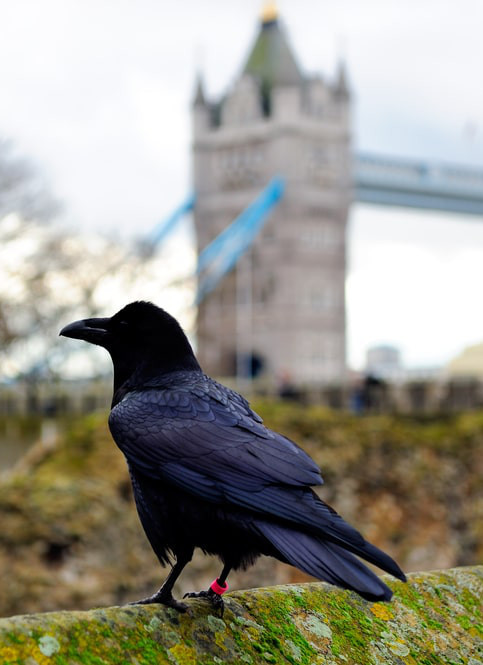
Legends and myths about trees
Celtic beliefs in trees (13)
F for Fearn (Alder) - March 18th - April 14th
“The tree of Bran the Blessed - Fourth month of the Celtic tree calendar (Ref)”
Colour: purple; Gemstone: amethyst; Gender: male; Patrons: Bran, Apollo, Aranrhod, Odin, Lug; Symbols: shield + foundation, discrimination + inner confidence, loyalty
In Celtic also Norse mythology, March was known as the 'month of lengthening days', which wakes the alder from its winter slumber.
Alder trees are found in the northern hemisphere. Although it is a broad-leaved tree, only alder bears cones, so it is easy to recognise them at a glance in winter. Alder wood can survive completely submerged in water, and never far from water, Alder trees can most often be found lining the banks of a stream, loch, or river, or in boggy wet ground and swamps.
Alder trees, which fix nitrogen around their roots, are also soil-enriching blessing trees. The alder tree, which does not rot even when in water, appeared to be a source of great mystery to the ancients. However, the main reason why the ancient Celts worshipped the alder tree was its sap turns a deep red when exposed to air, as if cutting it would cause it to bleed.
The alder month is a time when the days lengthen, the winter chill slackens and the sun gains momentum, and the ancient Celts would have been uplifted by the blossoming of the alder and its various blessings. The alder tree, which sacrifices itself to fertilise the soil, was also considered sacred. While it was also said to protect the road leading to fairyland, it was also believed that if an alder was cut down, the person's house would burn down in a fire. According to Irish legend, the first man was made from an alder tree and the first woman was made from a rowan tree.
The alder is the totemic tree of Bran the Blessed, the god. He is a giant and king of Britain in Welsh mythology. According to legend, after fighting the Irish, Bran knew he was dying and ordered his fellows to cut off his head and bring it back to London. The party spent 7 years in Harlech and 80 years in Benbrook on the way, but Bran's head remained alive and undecomposed. Bran's head was buried in the White Hill below the Tower of London. Bran's totemic bird was the raven, so 2 ravens are kept at the Tower of London, but their wings have been clipped. This is because legend has it that if the ravens abandon the Tower of London and fly away, the UK will be destroyed.
Apparently, the ravens are loved and looked after, really well by the Beefeater Guards.
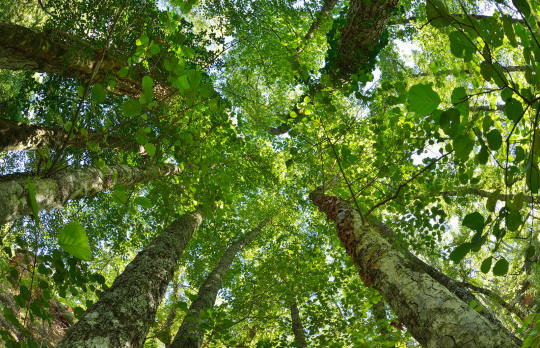
木にまつわる伝説・神話
ケルト人の樹木の信仰 (13)
FはFearn (ハンノキ) - 3月18日~4月14日
『祝福された人ブランの木〜 ケルトの木の暦(参照)の第4月』
色: 紫; 宝石: アメジスト; 性: 男性; 守護神: ブラン、アポロ、アランロド、オーディン、ルグ; シンボル: 楯+基礎、識別力+内なる自信、忠誠
ケルト神話や北欧神話では、ハンノキを冬の眠りから覚ます「日が長くなる月」として知られていた。
広葉樹でありながら球果をつけるのはハンノキだけなので、冬にはひと目で見分けることができる。ハンノキの木は完全に水に浸かっても生きてい��るので、小川、湖、川の岸辺や、湿地帯、沼地など、水辺でよく見かけることができる。
根の周囲に窒素を固定させるハンノキは、土壌を豊かにする恵みの木でもある。水の中にあっても腐らないハンノキは、古代人にとって特別な木に見えた。昔はハンノキを切り倒して沼沢地に道を造り、クラノグ(湖上住居)も、ハンノキで立てたのだ。しかし、古代ケルト人が、ハンノキを崇拝した最大の理由は、樹液が空気に触れると深い赤色になり、まるで切ると血が出るかのようだからだ。
ハンノキの月は、日脚が延びて、冬の寒気がゆるみ、日差しが勢いを増してくる時期であり、ハンノキの花開き、さまざまな恵みに古代ケルト人たちの気持ちも昂揚していただろう。また、自分を犠牲にして土壌を肥やすハンノキは神聖なものと考えられていた。妖精の国へ導く道を守るとも言われる一方で、ハンノキを切り倒すと、その人の家が火災にあって全焼するとも信じていた。アイルランドの伝説では、最初の男性はハンノキからつくられ、女性はナナカマドからつくられたことになっている。
ハンノキは、ウェールズ神話に登場する巨人であり、ブリテンの王であるブラン神のトーテムの木である。伝説によれば、アイルランド人と戦ったのち、死期が近づいているのを悟ったブランは、自分の首を刎ね、ロンドンまで持ち帰るよう仲間たちに命じた。一行は途中ハーレックで7年、ベンブルークで80年過ごしたものの、それでもブランの首は腐敗せず生き続けた。ブランの首はロンドン塔の下に広がる白い丘に埋葬された。ブランのトーテムの鳥はワタリガラスであったので、ロンドン塔ではワタリガラスが飼われているが、翼が切られている。ワタリガラスがロンドン塔を見捨てて飛んでいってしまうと英国は滅亡するという言い伝えがあるためである。
ロンドン塔のワタリガラスたちはビーフィーター・ガードたちに愛され、本当によく世話をしてもらっているそうです。
#trees#tree legend#tree myth#legend#mythology#celtic mythology#alder#celtic tree calendar#4th month#spring#bran the blessed#ravens#nature#art#tower of london
127 notes
·
View notes
Text

Did you ever know that the Leaning Tower of Pisa is empty from the inside and not a multi-story residential tower?!
The Leaning Tower of Pisa
It is a cathedral bell tower in the Italian city of Pisa, built in the Field of Miracles.
Let's get acquainted with the Leaning Tower of Pisa from a structural point of view:
Its construction began in 1173 AD and they began to establish the bases and then the walls, and after the building reached the third floor, it was noticed that there was a slope.
Can you imagine that a tower weighing 14,500 tons is built on foundations 3 m deep and installed on sand and silt?!!
After discovering the slope, the engineers built the rest of the floors (external walls) so that the height of the floor in the inclined direction is greater than its height in the other direction.
Which increased the inclination of the tower due to the sinking of the foundations in a greater proportion in the soil, due to the increase in the weight of the floors.
Among the reasons why the tower did not collapse:
The construction continued for 199 years, and the construction halt in it for a long time is one of the reasons that allowed the soil to compact, which reduced the rate of inclination, and thus the tower did not collapse completely.
The clay soil helped and the main reason for the tower's tendency not to collapse and its resilience in front of 4 earthquakes.
The engineers calculated the center of gravity of the tower, and it was concluded from the calculations that the tower collapsed completely upon reaching a slope of 5.44 degrees. The tower was closed in 1990 at a tilt of 5.5 degrees, yet the tower did not collapse.
Attempts made to stop the tilt of the tower and not collapse:
Digging deep holes in the ground at a depth of 40 m, and installing the tower with iron cables through the holes. Liquid nitrogen was pumped, which led to the freezing of water in the soil and its expansion and contraction again, which led to the subsidence of the soil and the subsidence of the foundations, and consequently the slope of the tower at the rate of its inclination throughout these years.
They dug 361 holes and injected the soil with 90 tons of cement, which led to the tower's tilt strongly.
And finally, Soil Extraction was used in 1990:
The soil was removed from the non-slanted side so that the tower tilts in that direction, then iron cables were used to fix the tower bases in the ground and the slope was reduced to 4 bikes, and this was what it was at the beginning.
The engineers could have made it vertical, but they didn't want to lose its fame and tourist value because of its tilt.
And after that was completed, the tower was opened.
And it was confirmed that the tower could endure without any collapse for 300 years.
#Pisa#leaning tower of pisa#Italy#architecture#aes#aesthetic#aesthetics#lifestyle#style#mood#good vibes#vibes#landscape photography#landscape#travel#adventure#wanderlust#beautiful
120 notes
·
View notes
Text
So the red triangle in my path scheme:
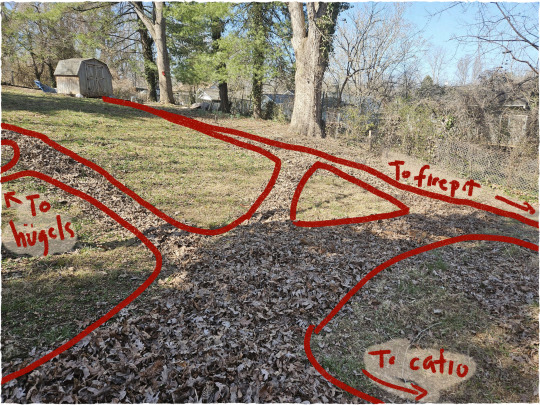
is now a plum tree guild.
Tilled in some compost from our kitchen waste pile. I have three piles strategically placed around the yard which I call my dirt factories, and I've spent about three years building them up. This is the first year I've used any of it and I was pleasantly surprised to find some nice dark crumbly compost under the layer of half-decomposed recent additions.
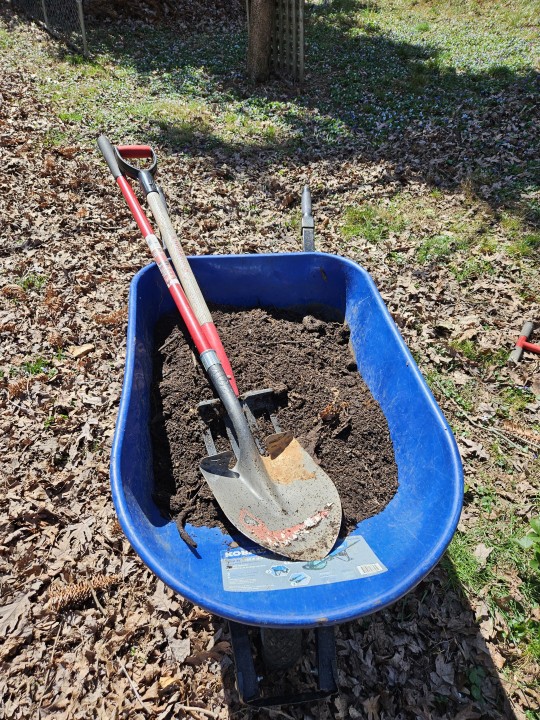

That barrow load was only about 1/3 of what I have. It just sort of looks like dirt but u can see the difference in the second pic against that clay soil. Which should be subsoil -- I live in a damn rainforest but the topsoil on my slope has been stripped after decades as a grass yard.
Tilled the area by hand which was laborious. Generally I have a strict no-till approach but this area was so stripped I figured it was worth disrupting it to add some compost. (also I could use the exercise I've been on T for a while and I'm not taking taking advantage of the gainz)
Anyway here is my new fruit tree guild planted, lined out, and mulched.

I put in a santa rosa plum, white lisbon bunching onions, quinault everbearing strawberries, and one Balkan yarrow. On the right side I will add some lupines for nitrogen fixing. I have a bunch on the other side of the path so it'll look real cute.
Also I bought a $30 stone cat

hehe
#the real reason I made this blog: so I'm not going wtf did I even plant here in six months#gardeners on tumblr#spring 24#planted#panthertown
10 notes
·
View notes
Text
Isekai Problems: Planting Roots
So what zones are your characters in?
Here I’m referring to the USDA plant hardiness zones for growing regions. There are similar maps for Europe; I saw one in a book on heritage roses once. So I’d guess other areas have made them as well. But the USDA’s the one I know best. It’s also the one I feel personally frustrated by, because I know it best.
Long story short. Hardiness zones are determined by the minimum temperatures the area reaches; you find Zone 1 and 2 up in inner Alaska, you find subtropical to tropical 9 and 10 in bits of Florida, Louisiana, and Texas. Plants can also be sorted by how heat tolerant they are, but freezing to death is a pretty good measure of where a plant can’t make it. If you look at a package of seeds marketed in the U.S., you’ll find the Hardiness Zone map on the back, often with suggested planting times.
However. Local weather patterns can make zones tricky.
Remember how I pointed out zone 9 in Florida? In fact, the Hardiness Zone map shows near the entire Gulf Coast as zone 9. If you look on a larger-scale and more finely detailed map, most of the near-shore will show up as zone 9a - not as warm as, say, central Florida at 9b.
Except that every two to three years there tends to be at least one hard freeze (temps dropping overnight below about 15 F), making the area technically zone 8b. So unless you’re lucky and have cut back and wrapped tender plants, all your banana trees and citrus go bye-bye.
And yet, because it’s not that cold every year, tulips and apple trees - any plants that need some cold dormancy - are likely to keel over too.
All of which means introducing new plants is always a roll of the dice. Can they take the cold and the heat?
If you’re going to introduce new crops, as characters sometimes do in isekai, have some idea about what conditions they need, and whether or not your new locale has them. Cochineal is one of the most beautiful, vibrant, colorfast reds in nature. But if you try to introduce it as a crop in, say, Siberia, when the cochineal scale insect lives on the warmth-loving Opuntia cactus... biologists and ecologists will have a sad. Really.
Likewise if you tried to grow Korean stone pines (nutritious seeds! Medicinal compounds!) in the fantasy equivalent of South Florida’s heat and humidity, people will talk.
You may have better luck with more conventional food crops. Rice, corn, wheat, potatoes - all of these have hundreds if not thousands of varieties, adapted for different conditions. There are rice varieties that tolerate salt enough to grow near shorelines, and a slow-growing, slime-shedding variety of ancient corn that hosts its own nitrogen-fixing bacteria; an awesomely useful feature usually only found in legumes. Human ingenuity and diligent searching may turn up or create a variety of a crop that can survive in what would normally be extreme conditions for that plant. But your story will feel more realistic if you make it clear you’re using magic or bioengineering to get oranges to survive in arctic tundra, or lingonberries in the Sahara. People have an idea of where plants flourish; putting them out of place without a good explanation dents suspension of disbelief.
Of course, temperature’s not the only consideration. Rainfall, soil minerals; is the earth acid or basic, sandy or heavy clay? All of these and more play a part. You don’t have to be an agronomist. Just check out some real-life analogues to what you’re working with to get ideas of what your characters need to do, and what curveballs you can throw at them.
And for goodness’ sake, if the original tamers of a crop grow it in a specific way that doesn’t use the whole field, don’t automatically assume it’s inefficient and you can do it better. Of such decisions are potato famines made....
11 notes
·
View notes
Note
Which plant do you have the most strong feelings about, positive or negative?
(sorry if this has already been asked)
I really love gourds, melons, and cucumbers because they grow so fast and have such an intimate history with humankind and have so many uses
my most hated plant is probably either Kudzu or English ivy, it’s kinda a tie. Kudzu is in the legume family so it “fixes” nitrogen into the soil, but not only that, fixes it into the air as well. So besides being incredibly invasive, destructive, and difficult to control , the bitch literally causes air pollutions

this is what it looks like. you can see how badly it suffocates local plant species. truly one of the Worst of all time
38 notes
·
View notes